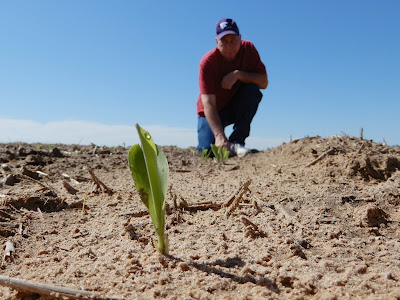
It's a philosophy of life I suppose I learned at my parents' dinner table. Both my brother and I seem to use it with some regularity. I believe the phrase has been transcribed on a homemade plaque at the family farmstead.

It is what it is.

In all honesty, Randy was a little disappointed with the yield. We had a lot of subsoil moisture at the beginning of the growing season. But I guess we just didn't get the rain and cooler temperatures we needed during grain filling. There were fairly large mudholes where no crop grew. As Randy says, "I guess it's Kansas."
How does Corn Harvest 2019 stack up with previous years' averages?
2019 - 66.6 bu/acre
2018 - 82 bu/acre
2017 - 43.6 bu/acre
2016 - 71 bu/acre
2015 43.88 bu/acre
2014 - 108 bu/acre
2013 - 57 bu/acre (This was the first year we added corn into the crop rotation).
When you reach the end of a season, it's always good to look back to where you've been. To read more about each stage, click on the links:
We started planting corn on April 15, 2019, and finished April 25 or so. Wheat has always been our primary crop. However, the prevented planting of wheat acres due to excessive moisture last fall meant an increase to those we devoted to corn on the County Line. The cost of planting corn is appreciably higher than the cost of planting wheat due to seed costs, fertilizer and herbicide. Because we are a totally dryland farm, wheat typically performs better than corn on our acreage.
We planted 600 acres of corn. To compare: In 2018, we planted 280 acres of corn.
The corn was emerging in early May.
 |
| June 21, 2019 |
As advertised in a song from a musical, the corn was "as high as an elephant's eye" in July.
 |
| July 8, 2019 |
By the end of August, the corn was starting to dry down. It was too dry to take to the feedlot for high-moisture corn and not quite dry enough to haul to the elevator.
Our corn wasn't a bumper crop. But neither was our wheat this year. This is the first time we have more corn bushels to sell than wheat bushels. (We planted 1,080 acres of wheat vs. the 600 of corn. Part of that is the difference in the size of the kernel. Corn kernels are bigger and heavier than wheat kernels. Corn typically produces more bushels per acre than wheat, and that was definitely true this year when we had the poorest wheat harvest we'd had in the 10 years I've been blogging.)
And so we finish up another task on the County Line.
It is what it is.
And, as one of my dad's other signs - and sayings - goes, we'll keep on hoeing.







Yes, not the worst but here's hoping 2020 makes the hoeing worth it.
ReplyDeleteWe'll do our best!
ReplyDelete